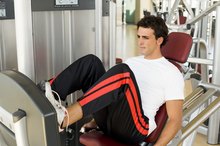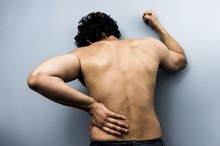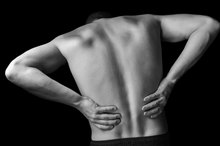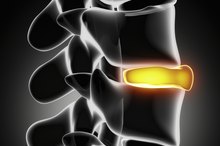How to Cycle With Lumbar Fusion
Lumbar fusion surgery will change your life, hopefully for the better. The surgery can relieve years of lower back pain, making physical activities like cycling not only possible but pain-free. The surgery is a serious one, however, and rushing back to your bike can have disastrous results. Don't even think about pulling on your bike helmet without your doctor's permission.
If you are experiencing serious medical symptoms, seek emergency treatment immediately.
Lumbar Fusion Basics
The goal of lumbar fusion is to relieve pain caused as a result of vertebrae moving in an abnormal way. Your surgeon will insert bone grafts in your spine, which will fuse with the existing bones of your spine over time and prevent the vertebrae from hitting one another. It takes several months for the bone graft to fuse to existing bone, so your surgeon may fix the graft in place using screws, rods or metal plates. You'll need to stay in the hospital for at least one or two days after surgery and will probably need to avoid exercise for at least a few months.
- The goal of lumbar fusion is to relieve pain caused as a result of vertebrae moving in an abnormal way.
- Your surgeon will insert bone grafts in your spine, which will fuse with the existing bones of your spine over time and prevent the vertebrae from hitting one another.
Preparing for Cycling
Hurt Left Side of the Lower Back After Leg Pressing
Learn More
Before you'll be ready to go cycling, you'll need to do rehabilitation exercises to strengthen not only your lower back, but also the muscles that have been weakened during your months of rest 3. Your doctor may recommend you start working with a physical therapist as soon as six weeks after surgery. The therapist may teach you to do exercises to strengthen and stabilize your back and encourage you to do low-impact exercise like walking until you've fully recovered from surgery. At this point, see your doctor again to request permission to return to cycling.
- Before you'll be ready to go cycling, you'll need to do rehabilitation exercises to strengthen not only your lower back, but also the muscles that have been weakened during your months of rest 3.
- The therapist may teach you to do exercises to strengthen and stabilize your back and encourage you to do low-impact exercise like walking until you've fully recovered from surgery.
Cycling After Surgery
Once you've received your doctor's blessing, ease back into cycling slowly. Start on a stationary bike. If possible, find a gym with a recumbent bike, which has a back rest and encourages you to sit up straight, thus keeping your spine in alignment. When you feel fully mobile and ready for a road bike, try adjusting the seat down so the handlebars are as high as possible. You may feel a bit awkward in this position, but the higher the handlebars, the less you'll have to hunch over and the straighter you'll keep your lower back. You may also find that switching to a smaller bike will be more comfortable.
- Once you've received your doctor's blessing, ease back into cycling slowly.
- If possible, find a gym with a recumbent bike, which has a back rest and encourages you to sit up straight, thus keeping your spine in alignment.
Considerations
Weight Loss After Lumbar Fusion
Learn More
Lumbar fusion isn't a guarantee that you'll never have back problems again 2. It's possible that your surgery won't be entirely successful, or that pain will return in the future, and cycling can exacerbate any problems. Assess how your back feels after a ride and contact your doctor if you notice you routinely feel pain after cycling. When you're not cycling, make an effort to stand and sit up as straight as possible. Wearing a back brace when you're at home may help support your back and remind you to use proper posture to limit your risks of lower back pain returning.
- Lumbar fusion isn't a guarantee that you'll never have back problems again 2.
- Wearing a back brace when you're at home may help support your back and remind you to use proper posture to limit your risks of lower back pain returning.
Related Articles
References
- Neurosciences.Beaumont.edu: Lumbar Fusion
- UMM.edu: A Patient's Guide to Posterior Lumbar Fusion With Pedicle Screws and Rods
- UMM.edu: A Patient's Guide to Rehabilitation for Low Back Pain
- American Academy of Orthopaedic Surgeons: OrthoInfo. Spinal fusion. Updated June 2018.
- American Academy of Orthopaedic Surgeons: OrthoInfo. Spinal fusion glossary. Updated June 2018.
- U.S. National Library of Medicine: MedlinePlus. Spinal fusion. Updated April 9, 2020.
- U.S. National Library of Medicine: MedlinePlus. Spine surgery. Updated April 9, 2020.
- American College of Surgeons. Medication and surgery: before your operation. Updated May 2019.
- Shaw KA, Griffith MS, Shaw VM, Devine JG, Gloystein DM. Harvesting autogenous cancellous bone graft from the anterior iliac crest. JBJS Essent Surg Tech. 2018;8(3):e20. doi:10.2106/JBJS.ST.17.00068
- Mayo Clinic. Pain medications after surgery. Updated February 22, 2020.
- U.S. National Library of Medicine: MedlinePlus. Acetaminophen. Updated April 20, 2020.
Writer Bio
Cooking, travel and parenting are three of Kathryn Walsh's passions. She makes chicken nuggets during days nannying, whips up vegetarian feasts at night and road trips on weekends. Her work has appeared to The Syracuse Post-Standard and insider magazine. Walsh received a master's degree in journalism from Syracuse University.









